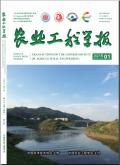农业工程学报2024,Vol.40Issue(13):15-24,10.DOI:10.11975/j.issn.1002-6819.202403109
设施园艺电驱移动平台轮毂电机设计及其磁-热耦合性能
Design and magnetic-thermal coupling analysis of the hub motors for horticulture electric drive mobile platform
摘要
Abstract
The hub motor-driven mobile platform has gradually replaced the traditional centralized electric drive system.There is ever-increasing demand for flowers,fruits,vegetables,and tea horticulture for the new energy-powered operating equipment,particularly with high efficiency,energy saving,compact structure,independent and controllable advantages.Compared with direct-drive hub motors,the geared hub motors have been the mainstream of the drive unit for facility horticulture,due to the higher overload and torque output.The operational requirements of large load and torque can be fully met in the operation scenarios of facility horticulture.However,the geared hub motors are limited to the size of the space inside the hub.The high heat generation has seriously restricted the operational performance of electric drive mobile platforms.In this study,a decelerated inner-rotor axial flux hub motor was designed to meet the requirements of the low-speed and high-torque traction for electric-driven mobile platforms in facility horticulture operation scenarios.The electromagnetic finite element(FE)model was established to analyze the electromagnetic and loss features of the hub motor.Moreover,an improved magnetic-thermal coupling FE model of the hub motor was also constructed using the thermal network.The effect of temperature on the winding resistivity was considered to reduce the prediction accuracy of the simulation model,compared with the conventional magnetic-thermal bidirectional model.The prediction accuracy of the torque was improved by 5.33%using the improved model,compared with the bench tests.The correctness of the model was verified using the magnetic-thermal coupling FE model.A systematic investigation was made on the influence of the temperature and phase current on the torque of the motor.The experiments were also conducted on the external efficiency of the hub motor under peak operating conditions.The simulation results reveal that the average output torque of the motor decreased,as the steady-state temperature increased.The prediction value of torque was deviated by less than 1.56%from the measured at the motor speed of 800 r/min.The output torque of the motor also decreased with increasing motor temperature.The output torque of 15.23 N·m was reduced by 7.66%at the current of 32 A,compared with the conventional.The experimental results demonstrate that the power of the hub motor increased with the increase of the rotational speed in the middle and low-speed ranges.The peak power was up to 4.59 kW,while the torque almost remained constant.The output torque also decreased with the increase of motor temperature.The average output torque of the motor was linearly related to the phase current in the range of 0 to 20 A.The efficiency of the motor was up to 93.2%in the middle speed range with the torques in the range of 300 to 600 N·m.This finding can provide a direct guideline for the structural design of hub motors and the magnetic-thermal multi-physical field coupling performance analysis.关键词
农业/电机/模型/热网络法/磁-热耦合/温升特性Key words
agriculture/motors/models/thermal network method/magnetic-thermal coupling/temperature rise characteristic分类
农业工程引用本文复制引用
鲁应涛,姜逸菲,刘逸龙,罗志涛,郑恩来,鲁植雄,沈成,汪小旵..设施园艺电驱移动平台轮毂电机设计及其磁-热耦合性能[J].农业工程学报,2024,40(13):15-24,10.基金项目
国家重点研发计划项目(2023YFD2000302 ()
2022YFD2001202) ()

